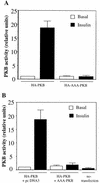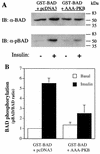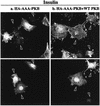Protein kinase B/Akt participates in GLUT4 translocation by insulin in L6 myoblasts
- PMID: 10330141
- PMCID: PMC104360
- DOI: 10.1128/MCB.19.6.4008
Protein kinase B/Akt participates in GLUT4 translocation by insulin in L6 myoblasts
Abstract
L6 myoblasts stably transfected with a GLUT4 cDNA harboring an exofacial myc epitope tag (L6-GLUT4myc myoblasts) were used to study the role of protein kinase B alpha (PKBalpha)/Akt1 in the insulin-induced translocation of GLUT4 to the cell surface. Surface GLUT4myc was detected by immunofluorescent labeling of the myc epitope in nonpermeabilized cells. Insulin induced a marked translocation of GLUT4myc to the plasma membrane within 20 min. This was prevented by transient transfection of a dominant inhibitory construct of phosphatidylinositol (PI) 3-kinase (Deltap85alpha). Transiently transfected cells were identified by cotransfection of green fluorescent protein. A constitutively active PKBalpha, created by fusion of a viral Gag protein at its N terminus (GagPKB), increased the cell surface density of GLUT4myc compared to that of neighboring nontransfected cells. A kinase-inactive, phosphorylation-deficient PKBalpha/Akt1 construct with the mutations K179A (substitution of alanine for the lysine at position 179), T308A, and S473A (AAA-PKB) behaved as a dominant-negative inhibitor of insulin-dependent activation of cotransfected wild-type hemagglutinin (HA)-tagged PKB. Furthermore, AAA-PKB markedly inhibited the insulin-induced phosphorylation of cotransfected BAD, demonstrating inhibition of the endogenous PKB/Akt. Under the same conditions, AAA-PKB almost entirely blocked the insulin-dependent increase in surface GLUT4myc. PKBalpha with alanine substitutions T308A and S473A (AA-PKB) or K179A (A-PKB) alone was a less potent inhibitor of insulin-dependent activation of wild-type HA-PKB or GLUT4myc translocation than was AAA-PKB. Cotransfection of AAA-PKB with a fourfold DNA excess of HA-PKB rescued insulin-stimulated GLUT4myc translocation. AAA-PKB did not prevent actin bundling (membrane ruffling), though this response was PI 3-kinase dependent. Therefore, it is unlikely that AAA-PKB acted by inhibiting PI 3-kinase signaling. These results outline an important role for PKBalpha/Akt1 in the stimulation of glucose transport by insulin in muscle cells in culture.
Figures









Similar articles
-
Maturation of the regulation of GLUT4 activity by p38 MAPK during L6 cell myogenesis.J Biol Chem. 2003 May 16;278(20):17953-62. doi: 10.1074/jbc.M211136200. Epub 2003 Mar 11. J Biol Chem. 2003. PMID: 12637564
-
Dependence of insulin-stimulated glucose transporter 4 translocation on 3-phosphoinositide-dependent protein kinase-1 and its target threonine-410 in the activation loop of protein kinase C-zeta.Mol Endocrinol. 1999 Oct;13(10):1766-72. doi: 10.1210/mend.13.10.0364. Mol Endocrinol. 1999. PMID: 10517677
-
Insulin but not PDGF relies on actin remodeling and on VAMP2 for GLUT4 translocation in myoblasts.J Cell Sci. 2004 Oct 15;117(Pt 22):5447-55. doi: 10.1242/jcs.01421. Epub 2004 Oct 5. J Cell Sci. 2004. PMID: 15466888
-
The protein kinase B/Akt signalling pathway in human malignancy.Cell Signal. 2002 May;14(5):381-95. doi: 10.1016/s0898-6568(01)00271-6. Cell Signal. 2002. PMID: 11882383 Review.
-
PKB/Akt: a key mediator of cell proliferation, survival and insulin responses?J Cell Sci. 2001 Aug;114(Pt 16):2903-10. doi: 10.1242/jcs.114.16.2903. J Cell Sci. 2001. PMID: 11686294 Review.
Cited by
-
Phenotype selection reveals coevolution of muscle glycogen and protein and PTEN as a gate keeper for the accretion of muscle mass in adult female mice.PLoS One. 2012;7(6):e39711. doi: 10.1371/journal.pone.0039711. Epub 2012 Jun 29. PLoS One. 2012. PMID: 22768110 Free PMC article.
-
Putting Rac1 on the path to glucose uptake.Diabetes. 2013 Jun;62(6):1831-2. doi: 10.2337/db13-0381. Diabetes. 2013. PMID: 23704529 Free PMC article. No abstract available.
-
Simulation of gastric bypass effects on glucose metabolism and non-alcoholic fatty liver disease with the Sleeveballoon device.EBioMedicine. 2019 Aug;46:452-462. doi: 10.1016/j.ebiom.2019.07.069. Epub 2019 Aug 7. EBioMedicine. 2019. PMID: 31401193 Free PMC article.
-
Muscle-specific knockout of PKC-lambda impairs glucose transport and induces metabolic and diabetic syndromes.J Clin Invest. 2007 Aug;117(8):2289-301. doi: 10.1172/JCI31408. J Clin Invest. 2007. PMID: 17641777 Free PMC article.
-
Dual neuroprotective signaling mediated by downregulating two distinct phosphatase activities of PTEN.J Neurosci. 2004 Apr 21;24(16):4052-60. doi: 10.1523/JNEUROSCI.5449-03.2004. J Neurosci. 2004. PMID: 15102920 Free PMC article.
References
-
- Alessi D R, Deak M, Casamayor A, Caudwell F B, Morrice N, Norman D G, Gaffney P, Reese C B, MacDougall C N, Harbison D, Ashworth A, Bownes M. 3-Phosphoinositide-dependent protein kinase-1 (PDK1): structural and functional homology with the Drosophila DSTPK61 kinase. Curr Biol. 1997;7:776–789. - PubMed
-
- Alessi D R, James S R, Downes C P, Holmes A B, Gaffney P R, Reese C B, Cohen P. Characterization of a 3-phosphoinositide-dependent protein kinase which phosphorylates and activates protein kinase B alpha. Curr Biol. 1997;7:261–269. - PubMed
-
- Bandyopadhyay G, Standaert M L, Galloway L, Moscat J, Farese R V. Evidence for involvement of protein kinase C (PKC)-zeta and noninvolvement of diacylglycerol-sensitive PKCs in insulin-stimulated glucose transport in L6 myotubes. Endocrinology. 1997;138:4721–4731. - PubMed
-
- Brown R E, Jarvis K L, Hyland K J. Protein measurement using bicinchoninic acid: elimination of interfering substances. Anal Biochem. 1989;180:136–139. - PubMed
Publication types
MeSH terms
Substances
LinkOut - more resources
Full Text Sources
Other Literature Sources
Medical
Research Materials
Miscellaneous
